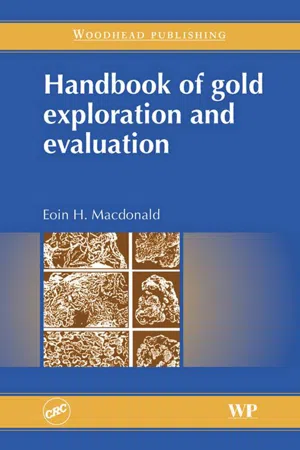
- 664 pages
- English
- ePUB (mobile friendly)
- Available on iOS & Android
Handbook of Gold Exploration and Evaluation
About This Book
Designed for geologists and engineers engaged specifically in the search for gold deposits of all types and as a reference for academics in higher schools of learning, Handbook of gold exploration and evaluation provides principles and detailed explanations that underpin the correct interpretation of day-to-day experience in the field. Problems are addressed with regard to the analysis, interpretation and understanding of the general framework within which both primary and secondary gold resources are explored, developed and exploited.Handbook of gold exploration and evaluation covers a comprehensive range of topics including the nature and history of gold, geology of gold ore deposits, gold deposition in the weathering environment, sedimentation and detrital gold, gold exploration, lateritic and placer gold sampling, mine planning and practise for shallow deposits, metallurgical processes and design, and evaluation, risk and feasibility.
- Covers the nature and history of gold
- Addresses problems with regard to the framework in which gold resources are explored, developed and exploited
- Discusses topics including the geology of gold ore deposits, metallurgical processes and design, evaluation, risk and feasibility
Frequently asked questions
Information
Nature and history of gold
1.1 Gold mineralogy
| Siderophile | Chalcophile | Lithophile | Atmophile |
| Fe Co Ni | Cu Ag (au)* | Li Na K Rb Cs | H N (C) (O) |
| Ru Rh Pb | Zn Cd Hg | Be Mg Ca Sr Ba | (F) (Cl) (Br) (l) |
| Re Os lr Pt Au | Ga ln Tl | B Al Sc Y Rare earths | Inert gases |
| Mo Ge Sn C P | (Ge) (Sn) Pb | (C) Si Ti Zr Hf Th | |
| (Pb) (As) (W) | As Sb Bi | (P) V Nb Ta | |
| S Se Te | O Cr WU | ||
| (Fe) (Mo) (Re) | (Fe) Mn | ||
| F Cl Br I | |||
| (H) (Tl) (Ga) (Ge) (N) |
| Element association | Deposit type |
| Au-As-Sb (CO2-Si) | Mesothermal. slate-hosted quartz-gold veins (e.g. Bendigo, Central Victoria). |
| Au-As-W-Ag-Sb-Te- ± Cu-Pb-Mo (CO2-S) | Archaean greenstone-hosted lode gold deposits (e.g. Kalgoorlie, Eastern Goldfields WA). |
| Ag-Au-As-Sb-Te ± Hg-Mn (S-Si) | Epithermal gold-silver veins in volcanic host rocks (e.g. Golden Cross, NZ, Gidginburg, NSW). |
| Au-As-Hg-Fe ± Sb-Te TI (Si-S) | Carlin-type disseminated pyrite-arsenopyrite gold-bearing systems. |
| Sb-Au (Si-S) | Quartz-stibnite veins in metasediments (e.g. Costerfield, Vic., Hillgrove NSW). |
| Au-Fe-As-Cu ± Zn (S-Si) | Quartz-sulfide veins containing Au associated with pyrite and arsenopyrite. |
| Hg-Cu-Au-S ± As-Bi-Co | Associated with ultrabasic rocks. |
| Cu-U-Au-Ag-REE (S-F) | Hydrothermal hematitic breccia complexes (e.g. Olympic Dam, SA). |
| Pb-Zn-Ag ± Cd-Cu (S) | Structurally controlled lead-silver veins and hydrothermal replacement bodies (Northhampton WA). |
| Fe-Pb-Zn-Cu-Ag ± Hg-Sb-Au (S) | Stratabound volcanic-hosted massive sulfide deposits (e.g. Woodlawn, NSW, Roseberry, Que River, Tas.). |
| Fe-Pb-Zn-Ag, Mn-Ba-TI ± Cu-As-Sb (S) | Shale-hosted stratiform lead-zinc deposits (e.g. McArthur River, NT). |
| Fe-Pb-Zn-Ag-Cu (S) Fe-Cu-Au ± Pb-Zn (S) | Turbidite-hosted sulfide vein systems (e.g. Cobar deposits, NSW). |
| Fe-Cu-Au ± Ag-Bi-Mo Te (S) Fe-Mo (S) | Porphyry copper-gold and porphyry molybdenum deposits in subvolcanic acid to intermediate rocks (e.g. North Parkes, NSW, Climax, Co.). |
| Cu-Au-Bi(S) Fe-Cu-Pb-Zn-Ag W-Mo ± Cu-Pb-Zn-Bi-As | Proximal contact replacement skarns (e.g. Browns Creek, NSW, Mt Biggendon, Qld, Old Cadia, NSW, King Island, Tas.). |
| Fe-Sn ± As-Cu-Zn (O-S-F) | Replacement tin skarns in carbonate units (e.g. Mt Bischoff, Renison, Tas.). |
| Cu-Pb-Zn-W-S | Sulfides and scheelite occurring within sediments and volcanic rocks. |
| Fe-Ni-Cu-Co-PGE (S) | Nickel-copper sulfide deposits in mafic/ultramafic rocks (e.g. komatiite-hosted deposits, Kambalda WA, Sudbury, Canada). |
| Ni-Co ± Mn (Si-O) | Ni laterites on ultramafic rocks (e.g. Greenvale, Qld, New Caledonia). |
| Cr-PGE-Ni-Cu (S-O) | Chromite lenses in layered ultrabasic rocks (e.g. Merensky Reef, S. Africa). |
| Fe-Ti-V (O) | Magnetite bands in layered mafic bodies and anorthosites (e.g. Bushveld Complex, S. Africa). |
| REE-Zr (CO2-P)-Nb-Ta-Cu | Carbonatite deposits (e.g. Mt Weld, WA, Palabora, S. Africa). |
| Cu-U-V ± Se-As-Mo-Pb | Redox front uranium deposits in terrestrial sediments (e.g. Lake Frome deposits, S. Africa). |
| U-V (K) | Calcrete uranium deposits (e.g. Yeelirrie, WA). |
| U-Au-Cu ± Zn-Sn-Pb-Bi, Pt-Pd | Stratabound and structurally controlled uranium-gold deposits in carbonaceous sediments (e.g. Alligator River, NT). |
| Sn-W-As-B ± Pb-Zn-Cu (O-S) | Porphyry style tin deposits (e.g. Ardlethan, NSW). |
| Sn-W-Mo-Cu-Pb-Zn-Au (F-B-Si-S) | Zoned vein systems in and around granites (e.g. Zeehan, Tas., Emmaville, NSW). |
| Ta-Nb-Sn-Li-Be (Si) | Pegmatites and complex veins associated with granites. |
| AI ± Nb-Ti-Ga (O) | Bauxite deposits. |
1.1.1 Elemental and native gold
– 0.0000142 cm/cm/°C (0 °C)
Electrical: – 0.452 × 106/cmΩ
Thermal: – 3.17 W/cmK
Table of contents
- Cover image
- Title page
- Table of Contents
- Copyright page
- Foreword
- Preface
- Acknowledgements
- 1: Nature and history of gold
- 2: Geology of gold ore deposits
- 3: Gold deposition in the weathering environment
- 4: Sedimentation and detrital gold
- 5: Gold exploration
- 6: Lateritic and alluvial gold sampling
- 7: Mine planning and practice
- 8: Metallurgical process and design
- 9: Evaluation, risk and feasibility
- Appendix I: Field laboratories and techniques
- Appendix II: Variogram structural analysis
- Appendix III: Sitework testing
- Appendix IV: Gold economics
- References and further reading
- Index
